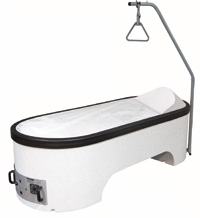Call Out the Big Guns
Air-fluidized therapy comes to HME providers courtesy of Blue Chip Medical’s Airus.
- By David Kopf
- Dec 16, 2010
 There are times when patients with very serious pressure ulcers or burns or other severe wounds need a support surface that goes well beyond what has traditionally been available from HMEs.
There are times when patients with very serious pressure ulcers or burns or other severe wounds need a support surface that goes well beyond what has traditionally been available from HMEs.
Providers have been able to offer incredibly advanced options, such as low-air loss, alternating pressure mattresses with multiple cells to ensure no area of a patient experiences too much pressure and that his or her skin stays dry. But when a patient has wounds that won’t heal using a Group 1 or 2 surface, you have to call out the big guns: air-fluidized therapy.
Air-fluidized therapy has been around for longer than 30 years, particularly in hospital settings. It is intended for patients recovering from skin grafts or burns, or patients with severe spinal injuries, as well as patients with multiple stage 3 and above pressure sores that will not heal. The technology has seen some homecare penetration, but it has never been available to providers. HMEs could offer Group 1 and Group 2 surfaces, but not Group 3. That is, until now.
To help HME’s deliver this solution to homecare patients for the first time, Blue Chip Medical Products has unveiled its Airus air-fluidized therapy system, says Jim Acker, vice president of sales and marketing for Blue Chip.
“The only air-fluidized systems out there have been available from manufacturers that have bypassed the dealer network,” Acker says. “They put the product under the patients and bill Medicare Part B themselves. So the dealer network has never had the opportunity to buy one of these products provide it themselves.”
So when the Airus went on display at Medtrade Fall last November in Atlanta, Blue Chip’s booth maintained a steady crowd of interested providers circling around the unit at its booth.
“The dealers were very excited to see that there was [an air-fluidized] product available,” Acker says of the attention. “Now they have the opportunity to provide a Group 3.”
Examining Airus
On casual observation, the Airus looks somewhat like a bathtub, but instead of being filled with water, it is filled with an incredibly fine micro-sphere bead media that resembles sand. On top of this layer is a thin skin of nylon fabric.
Inside the tub is an air-flow generator, and, when switched on, the air is pumped through the media. The Airus’s micro-sphere beads are so fine that when air is flowing through them they behave exactly like a liquid. With the skin pulled back from the Airus, the fluidized media looks like a sort of grey “milk” that splashes and bubbles as the air flows through it. However, the second the generator is switched off, the media reverts right back to behaving like the sand-like material that it is.
The nylon, air-permeable skin that goes on top of the air fluidized media is a critical element. The skin is made of a nano-filament nylon with a uniquely sized weave that ensures that the Airus’s micro-sphere media doesn’t get through the layer while air and liquid do.
When in use, the patient lays on Airus as though it were a bed. The system is switched on with air pumping through the fluidized media. The nano-filament lets the system bring air through the media and up to the wound, while drawing moisture away. The moisture is absorbed by the media, and the media that has absorbed the moisture then drops to the bottom of the tank (since the media has been fluidized).
Maintenance
For maintenance, the “clumped up” media can later be strained out with a sifter, and then that portion can be replaced with fresh media. Typically this procedure is required roughly once a month, which is not a major maintenance requirement, given that treatments last an average of 120 days.
Likewise, the skin is a launderable item so that it can be reused. The skin can be wiped clean as the patient uses it, or it can be swapped out when it becomes too soiled. Moreover, because of the mono-filament weave, nothing can get trapped in the fibers.
Another important feature is the base or “tub” of the Airus. Air-fluidized therapy systems can get heavy and hard to transport, which is not ideal for a homecare situation. One of the elements that makes the Airus lighter and easier to transport is the fact that it is modular. The air-flow blower system is removable leaving the 85-pound tank to be much more easily transportable.
The removable blower also comes in handy for repairs. If the Airus has a problem, the air flow system can be removed as one entire unit, and swapped out for a working item. Then the faulty unit can be taken back for repairs while the patient continues to treatment in his or her home. The air itself is conditioned and can be heated, depending on patient comfort.
The safe working load for the Airus is 400 pounds, but the provider would have to determine if the Airus would be appropriate based on patient size, as well.
Classified as a Group 3 support surface and billed under code E0194, the Airus becomes available this month.
Airus
Blue Chip Medical Products
www.bluechipmedical.com
(845) 369-7535
This article originally appeared in the January 2011 issue of HME Business.
About the Author
David Kopf is the Publisher HME Business, DME Pharmacy and Mobility Management magazines. He was Executive Editor of HME Business and DME Pharmacy from 2008 to 2023. Follow him on LinkedIn at linkedin.com/in/dkopf/ and on Twitter at @postacutenews.